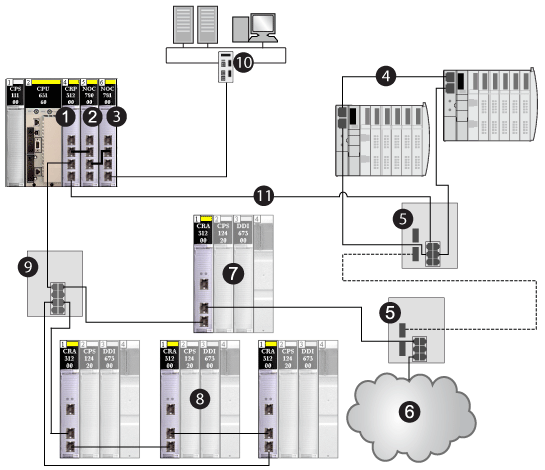|
|
Original instructions
|
|
Step
|
Action
|
|---|---|
|
1
|
Install one 140CRP31200 remote I/O head module, one 140NOC78100 control head module, and up to six 140NOC78000 distributed I/O head modules on the local rack, only three of which can be interlinked with the 140CRP31200 module and one which can be interlinked with the 140NOC78100 module to support a device network.
|
|
2
|
Connect the interlink port (ETHá2) of the 140NOC78000 module to the interlink port (ETHá2) of the 140CRP31200 module.
|
|
3
|
Connect the interlink port (ETHá2) of the 140NOC78100 module to the device network/interlink port (ETH 3) of the 140NOC78000 module.
|
|
4
|
Connect the start of the main ring to the device network port (ETHá3 or ETHá4) of the 140CRP31200 module.
|
|
5
|
Connect the end of the main ring to the device network port (ETHá3 or ETHá4) of the 140CRP31200 module.
|
|
6
|
Connect DRSs to the main ring for distributed I/O sub-rings and/or distributed I/O clouds.
Refer to the Predefined Configurations File topic in the Quantum EIO System Planning Guide for details on installing DRSs and distributed I/O devices.
|
|
7
|
Connect the control network port (ETHá3 or ETHá4) of the 140NOC78100 module to the control network.
|

1140CRP31200 remote I/O head module
2140NOC78000 distributed I/O head module interlinked with the 140CRP31200 module to manage the device network
3140NOC78100 control head module interlinked with the 140NOC78000 module to provide transparency between the device network and the control network
4distributed I/O sub-ring
5DRS with a predefined configuration file to support copper-to-fiber and fiber-to-copper transitions on the main ring
6distributed I/O cloud
7Ethernet remote I/O drop on the main ring
8Ethernet remote I/O sub-ring
9DRS connecting the remote I/O sub-ring to the main ring
10control network
11main ring